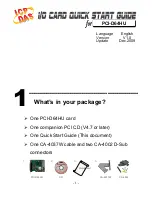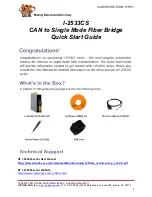25
b.
Select the access point that has already been established and connected.
When selecting the info icon, a screen will appear which will display an
option to forget the network and IP address assigned to the thermostat
by your router, sub-net mask, router, DNS and RSSI. If the RSSI signal
strength is anywhere between -9 to -69, then the signal strength is sufficient.
If outside this range, then either relocate the router closer to the thermostat,
add a repeater, or move the Central Hub. Adjusting antenna on router and/
or Central Hub may resolve the issue.
Special Considerations for 802.11b-Only Networks
The following information does not apply to networks that have a mix of
802.11b and 802.11g/n devices that are in a wireless network managed by an
802.11b/g/n access point.
NOTE:
802.11b-only networks are very rare, having been largely superseded
by wireless access points having 802.11b/g/n compatibility. But it is still
possible that an installer could encounter one. While a Central Hub
can connect to an 802.11b-only network, some Central Hub functions
will not be available and the practice is strongly discouraged. See
the Special Considerations for 802.11b-only Networks section in the
Appendix for more information.
While an 802.11b-only network will not prevent the successful installation, set
up, and commissioning of the HVAC system, and the ICON thermostat system
will operate the HVAC system properly, some important features of the ICON
thermostat system will not be available.
The Central Hub internal Wi-Fi module can maintain two separate Wi-Fi
connections simultaneously — one to the business Wi-Fi network and the other
to the Central Hub Wi-Fi local network — only if both networks use the same
signaling scheme. While 802.11b wireless devices and 802.11g/n wireless
devices use the same 2.4 GHz frequency band, 802.11b wireless devices use
DSSS signaling and 802.11g/n wireless devices (and the Central Hub local
network) use OFDM signaling.
So, if a Central Hub connects to an 802.11b-only network, it will not be able to
maintain connections to both the business Wi-Fi network and the Central Hub
Wi-Fi local network at the same time. It can use one or the other, but not both at
the same time. The Central Hub will be able to reach the Internet.
15.5.1.2 Ethernet
a.
When selecting Ethernet, the option for Ethernet settings will appear. Press
> next to Ethernet settings to continue.
b.
Choose either DHCP or Static. DHCP allows your router to assign the
IP address, submask, router name and DNS information automatically.
Selecting static you will need to manually enter the same information.
NOTE:
It is important that when entering the information manually for a static
setup, that the information entered does not conflict with another device
on the network.
c.
For static network connections, select
APPLY
to continue.
d.
Press the back arrow
(←)
at the top left side of the screen to return to the
previous menu.
15.5.2. Display Settings
Settings options for this screen is screen saver, brightness and daylight savings.
•
Screen savers options are 1, 2, 5, 10 minutes or never. Default is 1 minute.
• Brightness options are 0% to 100%. There is a slider tool that allows
adjustment.
•
Daylight savings options are either
ON
or
OFF
. Default is
OFF
.
• Press the back arrow in the upper-left hand corner of the screen to return to
Local Device Setup
menu.
15.5.3. General Settings
This area will allow you to set system date, time, time format (12 or 24 hour
clock) and temperature display format (either fahrenheit or celisus).
15.5.4. Installer Information
On this screen you can identify the installer for each type of equipment the
system has discovered. In the example below, both the HVAC and Refrigeration
Installer is available to edit.
These screens allow entry of installer information such as name, zip code, city,
state, country, address (2), phone, email and website. Once completed press
the back arrow (←) to return to the Installer information screen, and press the
back arrow (←) to return to the
local device setup
screen. Press finish end.
You will be returned to the Welcome to iCON! screen. A check mark will be
located next to each item that has been completed. Once done press the
finish
button to end the commissioning tool.
Please refer to the Setup and User Guide for details on configuring Energy
Monitor, Automation (custom alerts, HVAC control, dependencies and
schedules.
16. Replacement Parts
The following thermostat component parts can be ordered:
Table 5. Replacement Parts
Catalog #
Component
Remarks
16A92
Local Display
Thermostat interface
16A90
Central Hub
Control base
16A91
Mag-Mount
Wall mount for Local Display


















